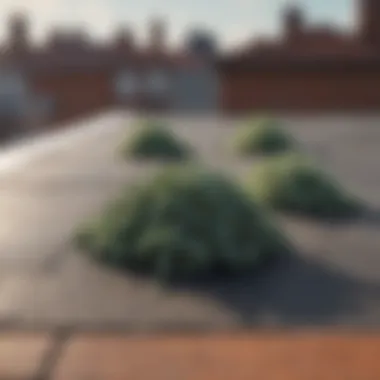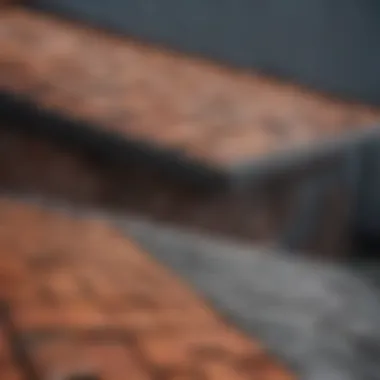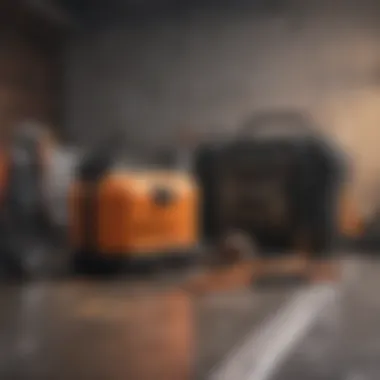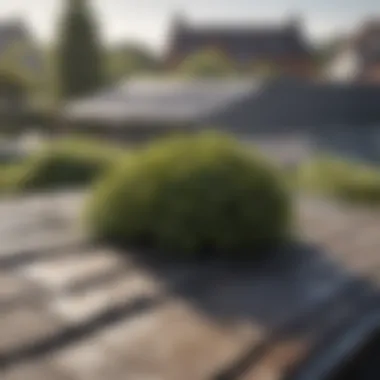A Comprehensive Guide to Removing Mould from Your Roof


Intro
Mould growth on roofs is a prevalent issue that many homeowners encounter. This unsightly problem can lead to serious complications if not treated properly. Understanding what causes mould, how to identify it, and the best methods to remove it can save time, money, and health concerns.
Mould thrives in damp, humid conditions. It often forms due to improper drainage, roof leaks, or lack of sunlight. For homeowners, tackling this problem is essential for maintaining both the structural integrity of their property and ensuring a healthy living environment.
In this guide, we will explore detailed strategies for effective mould removal. This includes both professional service options and do-it-yourself methods, allowing homeowners to choose the most suitable approach based on their specific situation. Preventive measures will also be discussed to help maintain a mould-free roof in the long term, ensuring the care of your home and the well-being of its occupants.
"Understanding the underlying causes of mould can be the first step in not just removing it, but preventing its return."
By implementing the techniques covered in this article, homeowners can achieve a sustainable strategy for mould management, leading to a healthier, safer home.
Understanding Mould Growth on Roofs
Mould growth on roofs is a significant concern for homeowners. Understanding its mechanics and the environment in which it thrives is vital for effective prevention and removal. Mould not only damages the roof's structural integrity, but it can also lead to health issues for residents. Thus, grasping the factors that contribute to mould development is key to maintaining a healthy living space.
The Biology of Mould
Mould is a type of fungus that plays a vital role in the ecosystem by breaking down organic matter. It reproduces through spores that are often windborne. These spores are almost everywhere, meaning that direct contact is nearly unavoidable. When conditions become favorable, these spores germinate, leading to mould growth. The key conditions include moisture, warmth, and a food source, which is abundant in roofing materials like wood.
Common Types of Mould Found on Roofs
Several types of mould can inhabit roofs. Some of the most commonly found include:
- Aspergillus: This mould can grow rapidly in moist environments and poses health risks.
- Cladosporium: Often found in damp areas, this black or green mould thrives in humid conditions.
- Penicillium: Recognizable for its blue-green color, it typically emerges in poorly ventilated spaces.
Identifying these types can aid in selecting the right treatment methods.
Environmental Conditions Favoring Mould Growth
Mould needs specific environmental conditions to flourish:
- High Humidity: Areas with higher-than-normal humidity levels frequently see mould outbreaks.
- Inadequate Airflow: Poor ventilation traps moisture, creating a favourable space for mould.
- Roof Age and Material: Older roofs or those made of materials that retain moisture are more susceptible.
Monitoring these conditions can help in taking proactive measures.
"Understanding the factors that aid mould growth empowers homeowners to better manage prevention strategies."
Focusing on these aspects will not only help understand how to tackle an existing mould issue but also how to minimize the risk of future occurrences.
Identifying Mould on Your Roof
Identifying mould on your roof is a crucial step in maintaining the health of your home. This process not only involves visually spotting the mould but also comprehending the various signs it presents. Timely detection can prevent extensive damage to your property's structure and avoid potential health issues for inhabitants. The importance of this section lies in enabling homeowners to recognize mould early. By understanding what to look for, they can take proactive measures to protect their roofing and overall home environment.
Visual Signs of Mould
Mould may manifest on roofs in various ways. Homeowners should look for visible discolorations on the roofing material. Common colors include black, green, or even white patches. When examining your roof, pay attention to the following:
- Discoloration: Look for dark patches, streaks or spots.
- Texture Changes: Mould may produce a fuzzy or slimy texture on the surface.
- Growth Patterns: Mould often appears in streaks that follow the angle of the roof, especially in shaded areas where moisture lingers.


It is advisable to inspect the roof after rainfall or periods of high humidity. Wet conditions promote mould growth, making it more visible soon after such weather.
Unpleasant Odors and Their Significance
Sometimes, mould is not visible, but its presence can still be detected through unpleasant odors. These musty smells often indicate the existence of mould somewhere on the roof or within the ventilation system. Homeowners should be aware of potential odours and consider the following:
- Source Location: Identify if the odour is stronger in specific areas.
- Duration of Smell: If a musty scent persists, it is a sign of a potentially serious mould issue.
Ignoring these odours can lead to more significant problems. Mould decomposes organic materials, releasing volatile organic compounds (VOCs), which may worsen indoor air quality.
Health Symptoms to Monitor
Mould does not only threaten buildings; it can also harm health. Monitoring health symptoms is essential for homeowners, especially those sensitive to mould spores. Key symptoms to watch for include:
- Respiratory Issues: Coughing, sneezing, or difficulty breathing can be linked to mould exposure.
- Allergic Reactions: These may manifest as skin rashes, itchy eyes, or skin irritation.
- Chronic Fatigue: Unexplained fatigue can sometimes be attributed to mould exposure.
If symptoms correlate with time spent in your home, it is critical to investigate possible mould presence. This connection can guide you toward sustainable health and a safe living environment.
Methods for Removing Mould from Roofs
Removing mould from roofs is essential for maintaining both the structural integrity of your home and the health of its occupants. The presence of mould can weaken roofing materials, lead to leaks, and create an unhealthy living environment. Understanding various methods to effectively eliminate mould will arm homeowners with the necessary knowledge to tackle this issue head-on. There are numerous strategies available, ranging from preparation and chemical treatments to eco-friendly solutions and professional services. Each method carries its own set of benefits and considerations, making it imperative to choose wisely according to the specific situation.
Preparation for Mould Removal
Preparation is the foundation of effective mould removal. The process involves several important steps. First, inspect the roof thoroughly to identify the extent of the mould growth. This may require using binoculars or a ladder, but it is vital to ensure safety at all times.
Next, consider the weather conditions. It's best to choose a dry day for the removal process, as moisture can hinder the effectiveness of cleaning agents. Ensure that all necessary tools are on hand before starting, which may include brushes, sprayers, safety gear, and any cleaning solutions you intend to use.
Additionally, protecting surrounding plants and landscaping is crucial. Cover any vegetation beneath the work area with tarps to shield them from chemicals or debris. Failing to do this can create unforeseen damage to your yard.
Using Chemical Treatments
Chemical treatments offer powerful options for removing mould. These products range from commercial mould removers to bleach solutions. When using chemical solutions, it's important to follow the instructions closely.
- Bleach: A common household choice is a mixture of bleach and water. This is effective in killing mould and can be sprayed directly onto affected areas. However, bleach can damage roofing materials if used excessively, so use it sparingly.
- Commercial Mould Removers: These are designed specifically for roofing use and often contain a blend of ingredients aimed at eliminating mould and preventing regrowth. Be sure to choose a product that is safe for your roofing material.
Employing Eco-Friendly Solutions
For those looking to avoid harsh chemicals, eco-friendly solutions are a worthy consideration. These options utilize natural ingredients that are less harmful to the environment.
- Vinegar: Vinegar is a natural mould killer. Spray undiluted vinegar on the affected areas and let it sit for at least an hour. Afterward, scrub and rinse the area.
- Baking Soda: Mixing baking soda with water creates a paste that can be effective in removing mould. Apply it to the affected areas, scrub, and rinse thoroughly.
These methods not only safeguard your roof but also keep the surrounding environment unharmed.
Professional Mould Removal Services
In cases where mould growth is extensive or persistent, seeking professional mould removal services might be necessary. Professional services provide expertise and advanced techniques for removing mould thoroughly. They are equipped with specialized tools and have access to industrial-grade removal products that can effectively tackle severe infestations.
Additionally, professionals can assess underlying issues that contribute to mould growth, allowing for a holistic approach to prevention and removal. While this may involve higher initial costs, the long-term benefits of a well-maintained roof can outweigh these expenses.


Cost Considerations for Mould Removal
Understanding the costs associated with mould removal is vital for homeowners. DIY methods such as using bleach or eco-friendly solutions usually incur minimal costs compared to hiring professionals. However, it is crucial to evaluate the extent of the mould and the required effort.
- DIY Costs: The expenses for cleaning supplies may range from $10 to $50, depending on the methods chosen.
- Professional Costs: Engaging a professional service to perform the same tasks can cost anywhere from $500 to $1,500 or more, depending on the severity of the issue and the size of the roof.
While DIY efforts can save money, sometimes investing in professional services might prove to be more cost-effective in the long run, especially if it prevents future mould infestations.
Regular assessments and timely interventions can mitigate costs and preserve the integrity of your roof.
Preventing Mould Growth on Roofs
Preventing mould growth on roofs is crucial for maintaining the integrity of your home. A mould-free roof not only enhances aesthetic appeal but also protects the underlying structure from potential damage. Mould can infiltrate roofing materials, leading to rot and costly repairs. Besides structural concerns, mould can also affect indoor air quality, which is especially important for families with members who have respiratory issues.
By focusing on prevention, homeowners can save time, resources, and stress in the long run. Implementing effective prevention strategies will allow for a healthier living environment. Let’s delve into some essential practices to ensure your roof stays mould-free.
Regular Maintenance Practices
Regular maintenance of your roof is essential. This includes cleaning gutters frequently to ensure proper drainage. Clogged gutters can lead to water pooling, creating a perfect environment for mould growth. Additionally, inspect your roof for debris such as leaves or branches. These can retain moisture and promote mould proliferation if not removed regularly.
Consider conducting thorough inspections at least twice a year, ideally in spring and fall. Look for any signs of wear and make repairs as needed.
- Clean gutters regularly to prevent water accumulation.
- Remove debris from roof surface periodically.
- Inspect for damage during seasonal changes.
Roof Design and Material Choices
When constructing or renovating a house, consider roof design and material. Some materials are more resistant to mould growth than others. For instance, metal roofs tend to resist mould better than asphalt shingles. If you are building a new roof, discuss with your contractor about suitable materials.
Avoid design aspects that create stagnant water areas. Ensure that your roof has a slope that allows water to drain efficiently. Incorporating design features that direct water away from the roof can mitigate mould growth.
Managing Roof Ventilation
Proper ventilation is key to preventing mould. Good ventilation allows moist air to escape, reducing humidity levels within the roofing structure. Without ventilation, humidity can build up, creating a perfect breeding ground for mould spores.
Consider installing ridge vents or gable vents to facilitate airflow. Ensure attics are also well ventilated, which further decreases the likelihood of moisture accumulation. Maintaining a balanced airflow is vital for a healthy roof.
Landscaping Considerations Around Your Property
Landscaping plays a significant role in roof health. Overhanging branches can provide shade and moisture retention, creating a mould-friendly environment. Trim back branches to allow sunlight onto the roof surface. Sunlight helps keep the roof dry.
Moreover, ensure that plants and other landscaping features do not obstruct proper drainage around the foundation. Wet soil close to the house can lead to moisture issues, affecting the roof indirectly.
The Importance of Monitoring Your Roof
Monitoring your roof is a critical aspect of home maintenance. Regular inspections can save homeowners significant time and expense. One of the most common issues that can arise on roofs is mould growth. Mould not only compromises the aesthetic appeal of a home but also poses serious health risks and impacts the structural integrity of the house. By understanding the importance of monitoring, homeowners can take proactive steps to avoid severe damage.
Frequency of Inspections
It is advisable to inspect your roof at least twice a year, ideally in spring and fall. Seasonal inspections ensure that any emerging issues can be addressed promptly. Extreme weather events, such as heavy storms or snow, can exacerbate existing problems. Homeowners should pay attention to their roofs after these occurrences. Frequent inspections help in identifying mould growth early, minimizing any potential damage.


Some factors that may influence the frequency of inspections include:
- Older roofs: These may require more frequent checks due to aging materials.
- Environmental conditions: Homes in humid regions are more prone to mould, necessitating regular monitoring.
- Nearby vegetation: Trees close to your roof can drop leaves and debris, providing an environment conducive to mould growth.
By establishing a consistent inspection schedule, homeowners can stay ahead of any issues, ensuring their roofs remain in good condition.
Documenting Changes and Issues
Keeping a record of changes and issues on your roof is essential. It provides valuable insights into recurring problems and informs future maintenance decisions. Take note of any signs of mould, discoloration, or other damage. Photographs can be particularly helpful. Documenting visually can help in tracking the progression or regression of mould growth over time.
Important details to include in your documentation:
- Date of inspection: This helps in maintaining an accurate timeline.
- Weather conditions: Record the weather during inspections as moisture levels can affect mould growth.
- Specific locations of mould: Noting where mould occurs can pinpoint underlying issues related to ventilation or drainage.
This practice of documentation aids in timely repairs and helps homeowners provide valuable information to professionals when seeking services.
Regular monitoring and documentation of your roof can prevent extensive damage and costly repairs down the line.
Being proactive about roof care fosters a safer living environment. It also assures that your home retains its value, keeping it a healthy place for you and your family.
When to Seek Professional Help
Removing mould from your roof can be a daunting task. While some homeowners might consider DIY methods for mould removal, there are times when engaging a professional is the best course of action. Recognizing when to seek expert assistance can save time, effort, and further damage to your property. The health risks associated with mould, including respiratory issues and allergic reactions, add urgency to addressing mould problems promptly. Not only do professionals have the right tools and expertise, but they also can ensure that the underlying issues causing mould growth are effectively dealt with.
Signs Indicating a Need for Experts
Several indicators can suggest that professional help is necessary. If you notice extensive mould growth covering large areas of your roof, it may be wiser to call a specialist. Mould can often return if not entirely removed, and improper methods can exacerbate the situation. When you find mould in hard-to-reach places or if your roof is particularly steep, using equipment safely becomes a critical concern.
Moreover, if you sense a persistent musty odour in your home, despite cleaning efforts, this could indicate deeper issues. Professionals can conduct comprehensive assessments. Just as concerning is what you can't see. Hidden mould can lurk beneath roof shingles and other areas, leading to structural damage if left unchecked.
Consider seeking professional help if:
- The infected area is larger than ten square feet.
- You experience symptoms of mould exposure, such as coughing or throat irritation.
- The mould returns after cleaning attempts.
- You suspect that the mould is linked to water damage.
Evaluating Professional Services
When opting for professional mould removal, it's essential to evaluate potential services carefully. Look for companies that provide thorough inspections before treatment, as this will ensure that they address the root of the problem rather than just the visible mould. Verify qualifications and experience when considering different services. Licensing and insurance are also critical. An adequately insured company can protect you from liability in case of accidents occurring on your property.
Another valuable aspect to gauge is customer feedback. Look for testimonials and reviews to assess their reputation in the market. Online platforms like Reddit and Facebook can provide insights into others' experiences. Before signing any contracts, ensure the service includes a detailed plan outlining methods and expected outcomes. Evaluating multiple services will help ensure you choose a company that aligns with your specific needs and budget.
"When mould presents a significant threat to your home, knowing when to seek professional help is essential for safeguarding your health and property."
In summary, understanding when to call in professionals can change the game in mould removal. Taking appropriate action will mitigate future risks to both your health and property.
Epilogue
In the context of maintaining your roof, understanding the implications of mould is crucial. This article illustrates the multifaceted approach required to combat mould effectively. By addressing the biological, environmental, and structural aspects, homeowners gain a holistic view of the challenges they face. The significance of mould removal is not only in the immediate aesthetic issues, but also in long-term structural integrity and occupant health.
Recap of Important Points
Mould on roofs can lead to severe consequences if left unaddressed. Key points from this article include:
- Understanding Mould Growth: Recognizing the biology of mould and the common types found on roofs empowers homeowners to identify issues early.
- Identifying Mould: Visible signs, unpleasant odours, and monitoring health symptoms are essential for timely action.
- Methods for Removal: Preparation, the choice between chemical treatments and eco-friendly solutions, and knowing when to call professionals are fundamental for success.
- Preventive Measures: Regular inspections, thoughtful design choices, and proper ventilation can avert mould problems altogether.
These points reinforce the urgency of monitoring your roof and addressing mould promptly.
Final Thoughts on Maintaining a Healthy Roof
Maintaining a healthy roof requires vigilance and a proactive approach. Regular inspections assist in early detection of mould and other potential issues. Homeowners should prioritize treatments and preventive measures to cultivate a long-lasting, mould-free environment. Engaging with this information empowers property owners to protect their homes and ensures the safety of all occupants.



